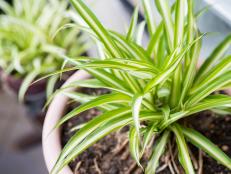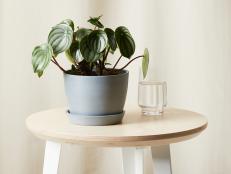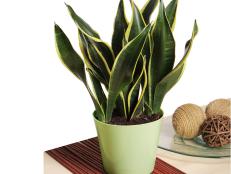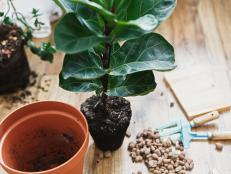How to Care for a Majesty Palm Indoors
Find out how to keep this tropical plant happy inside your home, plus discover more palms that lend a Tropics vibe with less fuss.

In its native tropical habitat, the majesty palm grows tall and sturdy, with its bulbous base tapering into a narrower trunk topped with arching fronds that sway in the warm breeze. Fortunately, as a houseplant, it grows slowly, and in its much smaller form, the palm (Ravenea rivularis is its botanical name) can provide a touch of the tropics to indoor décor.

Costa Farms
Alstroemeria (Majesty palm) and Diffenbachia are handsome additions to a houseplant collection.
Indoors, majesty palm grows best when you give it the conditions it needs to thrive. Native to the tropical regions of Madagascar, in the west Indian Ocean off the east coast of southern Africa, the plant enjoys bright light and consistently moist, but not soggy, soil. A majesty palm in dry soil will respond by turning brown at the tips and edges.
One of the biggest challenges to keeping a majesty palm happy indoors is providing adequate humidity. You can raise the humidity around the plant temporarily by misting it with a fine spray of water, but a better strategy may be to set the palm in its container on a tray filled with pebbles that are covered halfway with water. Don’t allow the pot to sit in the water, as that may cause the plant’s roots to rot. And clean the tray and pebbles regularly – every few weeks – to avoid the proliferation of fungus gnats or other pests.
More Choices for Palms
There are several other similar indoor palms that provide the same tropical vibe. If you prefer a palm that requires less coddling, consider one of these lower-maintenance choices:
- Parlor palm (Chamaedorea species): You can find these as small as dish-garden size or large enough to fill the corner of a room. A parlor palm can tolerate low-light areas and drier indoor air. Keep the soil slightly moist, but a parlor palm in soil that dries out occasionally most likely won’t suffer permanent damage.
- Areca palm (Chrysalidocarpus lutescens): This palm likes things a bit warmer – no cooler than 65 degrees at night — and does best in bright light (not direct sunlight). Keep the soil slightly moist, especially in spring and summer.
- Cat palm (Chamaedorea cataractarum): This is a tall, bushy palm with airy, delicate fronds. It prefers medium light and evenly moist, but not soggy, soil. It can grow to 3 to 5 feet tall and wide at maturity.

General Care of Majesty Palm and Other Indoor Palms
Watering: Most indoor palms do best when they receive consistent water. Browning tips is a sign of soil that is too dry. Majesty palm, especially, requires regular watering.
Fertilizing: Feed palms during the growing season with liquid houseplant fertilizer, following directions on the product. Some houseplant experts suggest using a weaker solution than recommended. Fertilize less during winter.
Pests: Aphids, mealy bugs, mites and whitefly are attracted to many indoor palms, including majesty palms. Watch for any of these pests and get rid of them as soon as you can. Insecticidal soap spray is usually an effective remedy for mites and whitefly, but treatment may have to be repeated. Aphids may be removed with a strong spray of water; you can remove mealy bugs with a cotton swab dipped in alcohol.













































